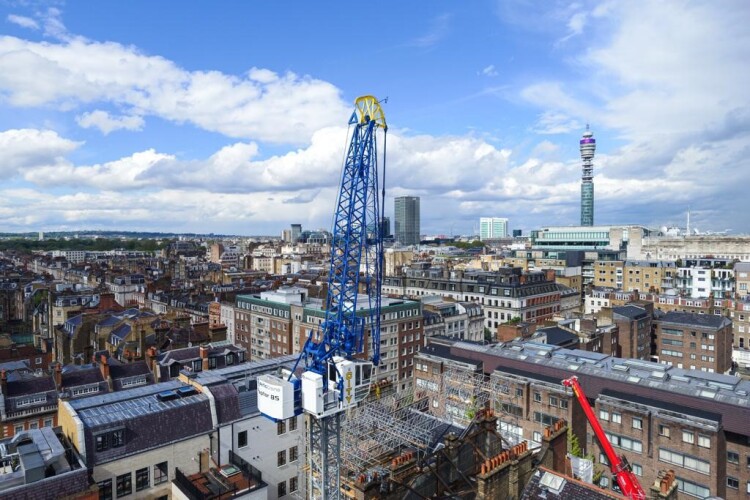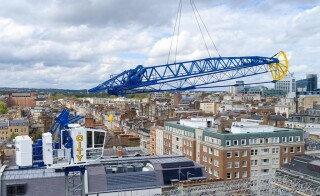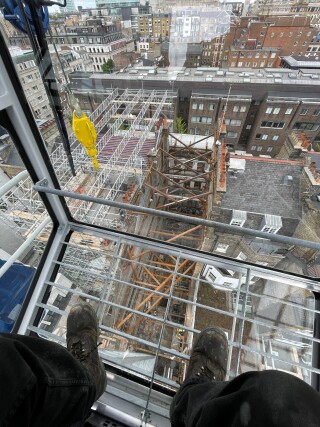“We call them the yellow-crested crane,” says Trevor Jepson, “even though there is no such thing.”
Trevor Jepson is the boss and owner of London crane hire company City Lifting and he’s talking about the Raptor, the current incarnation of gooseneck tower cranes seen across the capital’s skyline with increasing regularity over the past decade.
The ‘yellow-crested’ description refers to the paintwork of the jib’s highest section, where it folds. The rest of the crane is blue. The yellow marking serves the dual purpose of enhancing visibility for any passing helicopters and adding a distinctive styling that references the national colours of Sweden, where they are made.
This article was first published in the May 2021 issue of The Construction Index magazine. Sign up online.
It was back in October 2013 that this magazine last reported on the Raptors in City Lifting’s fleet. We explained how Swedish manufacturer Artic Cranes had produced a successor to the old Magni cranes made by Tornborgs, also in Sweden in the 1970 and ‘80s.
City Lifting has always been the manufacturer’s biggest customer. Just like Victor Kiam of Remington shaver fame, Trevor Jepson liked them so much he bought the company – well, some of it. That was back in 2011/12. He remains a junior shareholder and its keenest supporter.
Like the Magni, the distinctive feature of the Raptor is its articulated luffing jib. Luffing jibs are the preferred type of tower crane for restricted sites because the boom does not need to sail over neighbouring properties, unlike regular saddle jibs and flat-tops. But the articulated luffing jib gets in even closer, for the even more restricted sites, especially when not in use, hence its popularity in London.
“Its unsurpassed out-of-service radius is a phenomenal feature in narrow spaces,” Jepson says.
Until recently there were three different Raptor models, all represented in City Lifting’s fleet, the 48, the 84 and the 184. Now there is a fourth, the newly arrived Raptor 85, an upgrade on the 84.
The Raptor 48 is the smallest crane in the family, lifting a maximum load of three tonnes at a radius of 17.5m and with a low weight that makes it ideal for refurbishment projects, Jepson says.
The Raptor 84 was Artic’s very first crane, launched in 2010. It has a maximum load of four tonnes at 21m radius, or two tonnes at 32m, and a maximum tower height of 100m. It can lift at speeds up to 40m/min. It has an out-of-service radius of just 4m, which is a third that of regular luffing jib cranes, and a minimum working radius of just 1m, compared to 4m or 5m for regular luffers.
The Raptor 184, launched in 2017, is the biggest one to date, with a 36m jib, a maximum load capacity of eight tonnes at 22.5m radius, and a tower height of up to 150m.
The Raptor 85, new this year, is similar to the 84 but faster, stronger and more economical, using a lot less electricity thanks to a central power unit that returns any regenerated power back to the grid or other electrical loads on site. This means “big savings by the end of the job” Jepson says.
The 85 can lift a maximum of five tonnes out to a radius of 17.7m. And it has an even tighter out-of-service radius of 3.9m.
The jib end load is the same as the 84 for full-speed working but it can lift 2.2 tonnes with reduced speed, which is a 10% improvement on the 84 due to the lower dynamic forces.

The 85 also has two hoist motors, just like the 184. This balances the jib when lifting it and provides improved safety as the crane has two hoist brakes instead of one.
The first unit was delivered to a Swedish customer. The second was erected in London’s Harley Street by City Lifting at the back end of May for a 32-week job.
It is a classic site for a gooseneck crane. From the street, you might have no idea what main contractor Blenheim House Construction is doing for the Marylebone landlord, Howard de Walden Estate, but the presence of the tower crane tells you it is more than just a bit of decorating.
In fact, behind the retained façade, a 19th century townhouse is being totally reconstructed from the inside to create a modern workplace with all the technology and convenience one would expect for the 21st century.
Jepson says: “This site is only 9m by 50m but the Raptor 85 can work completely within the site boundary. As maximum capacity can be achieved on a single fall of rope, only a small hook block is needed, which is helpful when lifting next to the walls and through the flying shores.
“Other advantages of the Raptor are the small tower size [1.2m], a very fast jib speed with a level hook path and the fast slewing speed when the working radius is under eight metres.
“The driver can easily see the end of the jib at all times as it is always at the same level as the cab. We fit floodlights and a very good camera system to the jib which gives the driver full visibility of the load and the obstructions above and below the hook.”
Another design feature of the Raptor crane is that the entire folded jib, complete with reeving, can be assembled in a single lift, taking just 20 minutes to put up, compared to three hours for any other crane jib, Jepson says.
However, despite the undoubted merits of the new crane, it will be a few years yet before it has accrued enough rental revenue to start contributing a profit for City Lifting. That’s the nature of the business; it’s the old machines, those that are all paid for, that make the money. Fortunately, Jepson has these too, although fewer by the month.
In December 2016 he bought Vertical Transportation, the Leighton Buzzard based crane hire company that originally pioneered the gooseneck concept in the UK with Tornborg’s Magni.
Tom Newell and Ray Balach had set up Vertical Transportation in 1980 with Swedish backing but, having reached the ages of 78 and 77 respectively, they had decided it was time to stop climbing tower cranes and call time on their long careers.
The acquisition came with a selection of Tornborgs Magni S-46 goosenecks (also sometimes called jack-knife cranes) and Krøll K103V double level luffing jib cranes; the latter have since been upgraded with the latest controllers, inverters and motors; the former provide tower sections for the small Raptor 48s.
This article was first published in the May 2021 issue of The Construction Index magazine. Sign up online.
Vertical Transportation remains a separate company from City Lifting, despite the common ownership, although cranes may move between the two. Vertical Transportation is looked after by Jepson’s son Sam. City Lifting has always been a family business, co-owned by Jepson and his wife Clare. Another son, Dan, looks after the IT side of the business and one of their daughters has just started with the company and is currently organising all the training.
So gradually, a new generation is emerging to take over from its predecessors – both within the company and within the hire fleet. And as the Raptor fleet gets steadily larger, and more of it gets paid off, the old Tornborgs are steadily phased out. Jepson had 27 on acquisition five years ago, of which only eight remain.
[Editor's note: In the printed edition, we erroneously quoted Trevor Jepson calling his crane 'yellow-breasted' instead of 'yellow-crested'. Apologies, Trevor!]Got a story? Email news@theconstructionindex.co.uk





